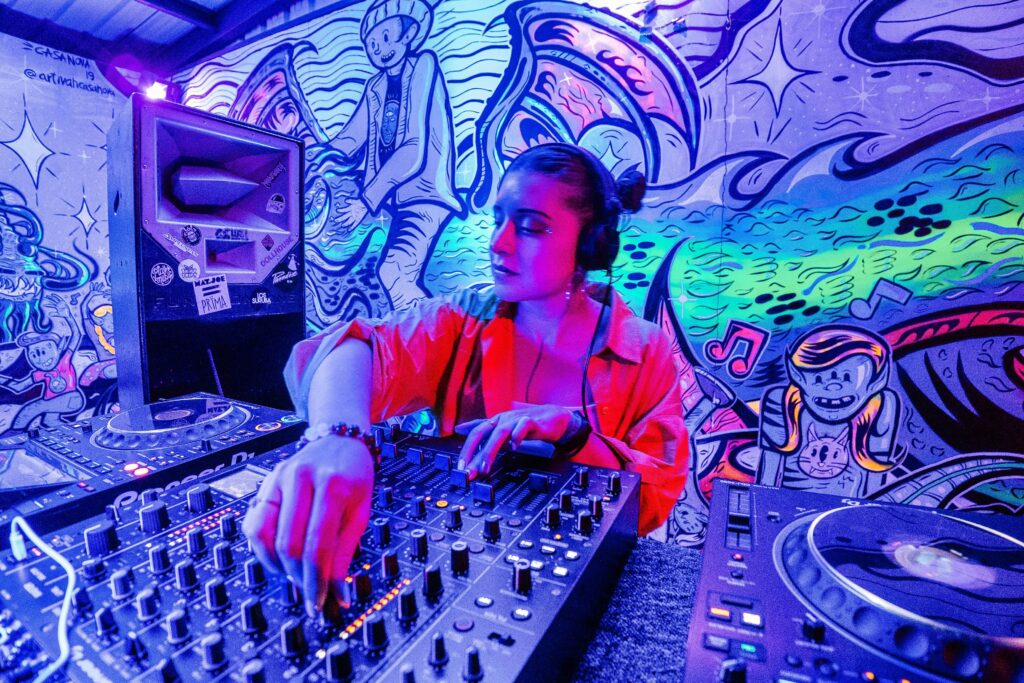
Picture this: you’re an EDM artist closing your books in October. You’ve earned flat fees for soft-ticketed shows, collected royalty checks from your label and publisher, and generated extra income from fan contributions on direct-to-consumer platforms like Bandcamp, where you sold exclusive tracks that didn’t make your last album. To round things out, you streamed a live DJ set on Twitch and brought in a few thousand dollars through Bits and other digital gifts.
Until recently, the IRS treated every dollar of that income the same way: taxable. But with the US government’s passage of the One Big Beautiful Bill in July and the rollout of its Section 70201, “No Tax on Tips,” parts of that income may now be treated differently for federal tax purposes. Under certain conditions, this new rule could allow artists to retain more of the revenue they earn directly from their fans.
To understand how this change works, it’s important to look at how the law defines the “tipped economy.” The “No Tax on Tips” provision applies to any occupation “which customarily and regularly received tips on or before December 31, 2024.” To clarify what this includes, the U.S. Department of the Treasury released a preliminary list of 68 occupations eligible for the deduction. Among them are Musicians and Singers, Disc Jockeys (except radio), Entertainers and Performers, and Digital Content Creators.
Most of these creative roles also fall under what the IRS calls Specified Service Trades or Businesses (SSTBs), a category that usually limits how much self-employed artists can deduct from their income. For years, that classification has kept performers, DJs, and songwriters from benefiting from the same tax breaks available to other small business owners. What makes the “No Tax on Tips” rule stand out is that it temporarily loosens those restrictions, allowing artists to treat qualified tips differently and keep more of what they earn directly from fans.
For artists and their teams looking to take advantage of this tax provision, there are a few key considerations to keep in mind. First, the “No Tax on Tips” provision is temporary and primed to sunset in 2028 unless Congress extends it. This gives artists a four-year window to take advantage of the benefit.
Second, artists can only deduct up to $25,000 each year in what the statute defines as “qualified tips” from their federal taxable income. According to the bill, a qualified tip must be paid voluntarily, without negotiation or obligation, and determined solely by the customer. It must be received in cash, by check, or via an electronic payment system. Payments that are required, prearranged, or contractual—such as appearance fees or subscriptions—do not qualify. In essence, discretionary fan contributions are treated differently from structured or mandatory payments.
As Tate Henshaw, Co-Founder of ARC Business Management, explained in an interview with EDM.com, defining “tips” in the music world is not as straightforward as in other industries.
“In the service industry, it’s easy to tell what’s a tip and what isn’t,” Henshaw says. “In music, that distinction hasn’t existed before.”
He points out that when someone tosses a few dollars into a street performer’s guitar case, that’s clearly voluntary and would likely qualify. But on digital platforms, where tips, subscriptions, and gifts are often bundled together, the lines begin to blur. For instance, if an artist charges a $10 monthly subscription on Twitch and receives an additional $100 in digital gifts, the $100 may count as a qualified tip, but the subscription payment would not. Determining which income qualifies will depend on how artists and their teams categorize and track it.
A major gray area that artists and their teams will need to navigate, especially when it comes to tips over digital services, is whether deductions should be calculated based on the gross amount fans contribute or the net amount after transaction costs and service deductions. The law doesn’t yet specify, leaving this detail to future IRS and Treasury guidance. Even with these uncertainties, the “No Tax on Tips” provision is significant because it can be claimed in addition to the standard deduction.
Consider this: a single artist earning $40,000 in total income, including $10,000 in tips, would normally take the $15,750 standard deduction for 2025, leaving $24,250 subject to tax. With “No Tax on Tips,” an artist reporting $10,000 in qualified cash tips could deduct that full amount from their taxable income, lowering it from $24,250 to $14,250. At a 12% taxable rate, that’s about $1,200 in potential tax savings. In effect, voluntary fan contributions now serve as both a revenue stream and a legitimate tax-saving tool when properly documented.
Because artists and entertainers are classified as a specified service trade or business (SSTB), they’re already subject to tighter scrutiny when it comes to deductions tied to service-based income. The IRS is likely to view this tip deduction through the same lens, meaning documentation standards for artists may be stricter than for other types of workers. Artists should ensure that their fan tips can be clearly separated from royalty, appearance, or subscription income, each of which remains taxable under SSTB rules.
The law also introduces some limits and eligibility requirements artists need to keep in mind. First is the phase-out rule. If an artist’s adjusted gross income exceeds $150,000 for individuals or $300,000 for joint filers, the deduction is reduced by $100 for every $1,000 above those thresholds. For instance, an artist earning $180,000 would see the $25,000 cap reduced by $3,000, leaving $22,000 deductible. An artist earning $400,000 would lose the deduction entirely.
Additionally, there’s a profitability requirement for the self-employed artist. If an artist’s total business expenses exceed gross receipts for the year—meaning they operated at a loss—they cannot claim the deduction, even if the tips themselves were voluntary and legitimate.
To make the documentation process easier, the law requires employers and digital payment platforms to issue statements that clearly identify cash tip amounts and specify the occupation of the recipient. For example, platforms like Twitch, YouTube, and Cash App will now distinguish fan tips from royalties, ad revenue, or subscription payments to comply with federal reporting requirements. Although this is helpful to artists and their teams, Henshaw noted that accurate record-keeping still remains critical to ensuring artists can fully benefit from and take advantage of the “No Tax on Tips” provision. That record-keeping, according to Henshaw, can be achieved by maintaining detailed payout reports, dashboard summaries, and individual transaction records to substantiate tip income reported to the IRS.
Recognizing the administrative burden of those qualified artists, Congress has included a one-year transition period for 2025, allowing taxpayers to rely on “reasonable methods” approved by the Treasury to estimate tip income. Beginning in 2026, however, precise reporting will become mandatory, with the IRS directed to closely monitor compliance. For artists, this makes 2025 a pivotal year to establish proper systems and workflows with their teams to take full advantage of the “No Tax on Tips” provision over the next four years.
While this new provision gives artists a tool to earn more, those looking to take advantage of it face major market headwinds: most notably the growing frustration and fatigue among consumers around tipping culture. Tipping in restaurants has now fallen below 15%, according to Square, and a recent Popmenu survey found that 77% of Americans are “fed up” with constant tipping prompts, with many saying they’ve spent around $150 on tips they didn’t view as customary or necessary. In other words, Congress has elevated tipping to a privileged tax category for artists at a time when consumers are increasingly reluctant to give them.
As consumer sentiment continues to shift, and as the Treasury releases further guidance on the “No Tax on Tips provision,” DJs weighing whether to take advantage of it need to recognize that this is not a blanket exemption, but a tightly defined deduction. At its core, it’s a policy that rewards precision, transparency, and strong record-keeping.
Navigating these complexities will require working closely with qualified tax and business professionals who can interpret new guidance as it emerges and help artists design systems that align with compliance expectations. Beyond the paperwork, the “No Tax on Tips” provision gives artists a chance to rethink how tipping fits into their business models and fan engagement strategies. For some, tips may become a new layer of direct support and smart tax planning; for others, it may not align naturally with how their fanbase engages or contributes.
For years, SSTB restrictions have left creative professionals at a tax disadvantage compared to other entrepreneurs. While temporary, the “No Tax on Tips” provision represents a meaningful step toward recognizing artists not just as entertainers, but as small business operators deserving of equitable treatment under the tax code. It also challenges artists and their teams to ask an important question: “How—if at all—should tipping fit into my business model? And if it does, how can it help me not only earn more, but keep more of what I’ve worked hard to build over the course of a year?”
Those who take the time to assess their situation, plan carefully, and collaborate with teams who understand the full financial picture will be best positioned to benefit from this new tax provision. For at least the next four years, “No Tax on Tips” will serve as a significant consideration for artists across the United States, and one that has the potential to reshape how creators think about income, compliance, and long-term financial strategy.
Disclaimer: This story is auto-aggregated by a computer program and has not been created or edited by beatsway.
Publisher: Source link
Top Categories
Recent News
Daily Newsletter
Get all the top stories from Blogs to keep track.




